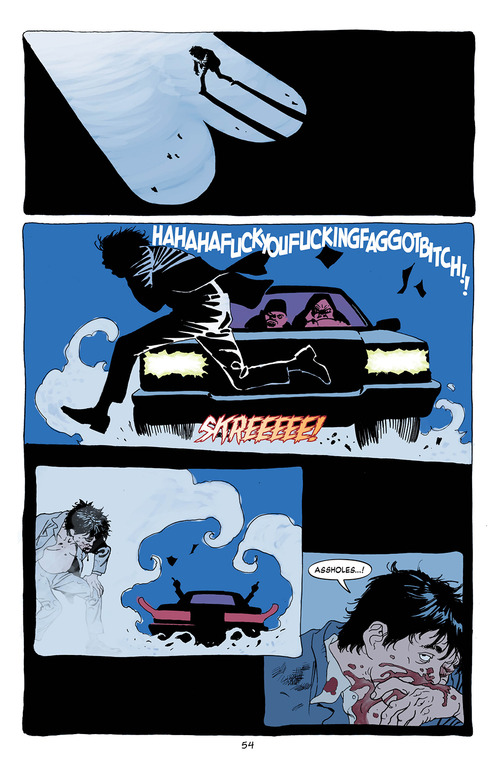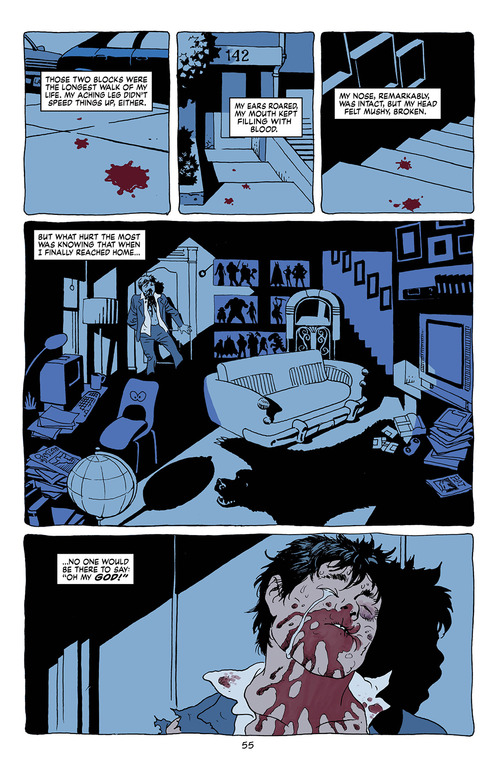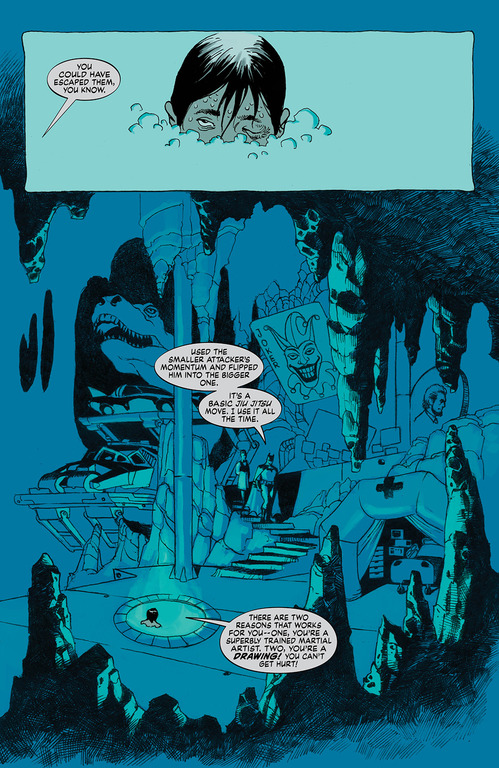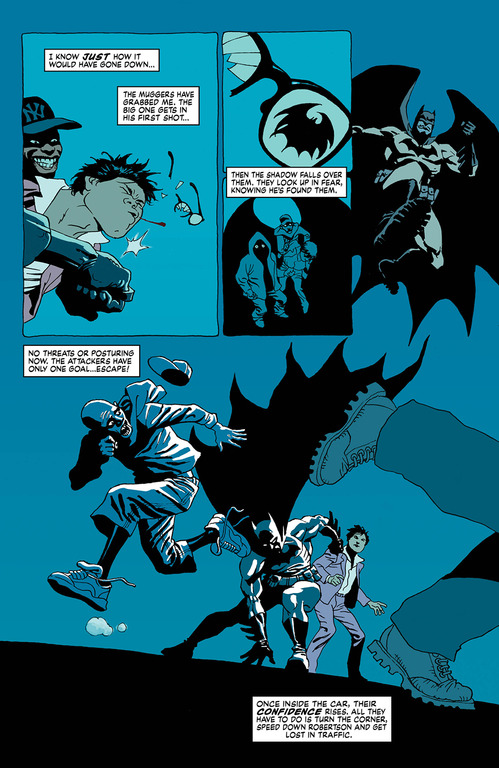“You are more than what your attackers took from you”: Paul Dini Heals Wounds of Assault in Dark Night: A True Batman Story
Cover Art by Eduardo Risso Comics Features Batman
Roughly two and a half decades ago, one of the most poignant voices behind one of pop culture’s biggest icons experienced a crisis of faith. Paul Dini has guided the adventures of the Dark Knight throughout animation (Batman: The Animated Series, Batman Beyond), comics (Detective Comics, Batman: Streets of Gotham) and gaming (Batman: Arkham Asylum, Batman: Arkham City), just to name a few of his projects. But a chance encounter with two muggers in Beverly Hills left the producer, editor and writer wounded on multiple levels. Not only did the assailants leave parts of his skull “powdered on impact,” requiring a handle fastened to his head to properly heal (Kool-Aid Man jokes abound), but they also robbed him of his passion for cape-and-cowl vigilantes.
Dark Night: A True Batman Story frames those struggles—internal and physical—with striking, moody art from Eduardo Risso (100 Bullets). Dini lays his soul bare, channeling his psyche through Batman (a harsh superego urging him to rally), Joker (a nihilistic downer cackling at the human spirit) and other inhabitants of the Bat mythos. The graphic novel asks huge questions: do the costumed men and women of our funny books simply distract us from the harsh realities of the world? Are their tales of impenetrable optimism a lie? Are predatory actresses more manipulative than Poison Ivy? Dini offers no easy answers, but does reach conclusions both profound and humanizing.
This graphic novel stands as one of the bravest, most vulnerable works of the medium in years, transcending one man’s redemption from a hospital bed to a manifesto for why our culture will always need heroes, no matter if they’re bound behind panels. Paste spoke with Dini on the phone to discuss his healing process, projecting demons into comics and the curse and blessing of childhood creativity.
![]()
Paste: Thank you for writing this graphic novel—I can only imagine how many people it will help who have gone through similar circumstances, but also for the bravery it must have required to revisit these events.
Paul Dini: It’s kind of like kicking the lid off Pandora’s box and looking at the little demons again. The upside is that it made me remember a lot of the kindness and empathy that I felt from people around that time. That definitely helped me through the situation as well.
Paste: It’s been 23 years since the assault described in Dark Night. Why is now the time to channel that event in a graphic novel?
Dini: I felt that I had a certain perspective on the event and that time had given me a different view of my life, and where it’s been from that point. I felt that if I had written the story a few years after the incident, I would have been too angry or too confused or too…I felt like the story wasn’t entirely there yet. It’s a story that only time could help tell. After 23 years, my life has gone on and it changed in certain ways that I think are for the better. For one thing, I kept going. I had some really good success in my career once I went back and started telling those animation stories again. My life straightened out as a person, I feel like I wouldn’t have met and married the woman who I love dearly.
Over those years I’ve seen people who I’ve been close to deal with some hardship. Some have gotten through it great, and some have stalled out. My writing this is a way of encouraging people to keep going. Also, it’s for the kids who find themselves pressured and bullied and victims of online harassment…kids who want to hurt themselves or give up—you don’t know. You don’t know how good your life is going to get. If you let tragedies stop you along the way, then you’re never going to grow as a person. If one guy can do it and set down his story in this way of using comic book characters, then maybe there’s a point to be made and other people can get that.

Dark Night: A True Batman Story Interior Art by Eduardo Risso
Paste: There’s one line from Batman: The Animated Series that’s always shaped my view of the character, and it was Alfred advising Bruce to drink chamomile tea because it helps with obsessive compulsive disorder. It alluded to Batman as someone who’s also coping—Bruce created his own fictional character, Batman, to deal with violence. In that way, you’re similar in that you’re both using storytelling to address these hardships. Do you feel closer to the character after channeling this event?
Dini: I know how to flavor Bruce Wayne’s attitude toward the world a little bit more, of what it means to pick up and start over again. Especially having a crime where there was no resolution, no closure, you’re faced with two choices: you either submit to your fears and your depression, or you do something about it and you continue on. I don’t have the resources or the initiative to become a superhero, but moving beyond the incident and going back to do what I do, that is a victory of sorts. At the end of the day, that’s what we have to console ourselves with. OK: I didn’t get any closure on a violent incident that happened to me, but I was able to survive and tell other people that they can do the same.
Paste: One parallel to your story is Frank Miller, who was mugged twice when he moved to New York City to begin his career, and those events supposedly helped create the gritty visions of Daredevil and The Dark Knight Returns. Did your experience alter how you wrote Batman in any capacity, whether in animation, your comics or the Arkham games?
Dini: He maybe got a little harder when I went back to write the animation. He was a little more grim, and a little more determined about crime fighting. Maybe he talked a little less about it. Certainly when I wrote Detective Comics and Batman: Streets of Gotham, I tried to limit his dialogue. I never imagined him to be a very verbose character, but being in a fight, being attacked and having to fend for yourself very quickly, there’s not a lot of internal dialogue that goes on, and your reactions have to be pretty quick and decisive. I would be writing an incident where he’d be in a fight, and I would recall being hit and use that here and there to flavor the action sequences. And instead of talking a lot about what he’s doing in the middle of a fight, I make his reactions just that: very quick, blunt reactions tasked to what he has to deal with.

Dark Night: A True Batman Story Interior Art by Eduardo Risso
Paste: One quote that I found especially beautiful was “You are more than what your attackers took from you.” How would you define what they took for you at this point in your life? Has that definition changed at all?
Dini: That’s a phrase that’s stayed with me for 23 years. That’s something I tried to remember while I was healing, but I also wanted to deliberately impart that to readers who have gone through a similar situation. You don’t have to limit yourself or feel that you’ve been limited by an act of cruelty. That line has always meant a lot to me.
Paste: What made artist Eduardo Risso the best fit for this project?
Dini: I really loved the work he’d done on his Batman stories and also on 100 Bullets. I felt like that he had a power and sensitivity to his artwork that really conveyed the story I was trying to tell. I didn’t want him to spare anything visually from the violence or also to limit himself in the quiet, funnier moments. Probably because 100 Bullets has such a powerful, visceral look to it, I felt that he would be really great in capturing those moments. I actually have a wall of my writing office pinned up with different collages I’d made while I was writing the story. There’s a little bit more of his work up there. I thought, Eduardo really has a knack for that kinetic storytelling that I need to show incidences of violence and action.
He also has a tremendous vision of Batman. That was incredibly important to me in the look of the book—it be Eduardo’s vision, and not a vision of the animated series. As much as I love the animated series, I felt that his work has to be in stark contrast to what the animated series looks like. And nor did I want the versions of Batman, Poison Ivy, Alfred and all the others to be the animated versions, I wanted them to be of his imagination. I wanted to show that this was a shared imagination. I didn’t want to art direct him too much. I wanted him to find inspiration in the story.

Dark Night: A True Batman Story Interior Art by Eduardo Risso
Paste: The coloring here sticks out to me the most. The jealous, frustrated yellows when you’re with Vivian seem especially symbolic, the greens when you’re reentering reality and possibly healing…How much of the mood coloring was coordinated to fit a specific emotion?
Dini: I let him do that. I let him tell the story. I didn’t call for any particularly look of the coloring. When I saw he was doing that, like putting all blues and blacks around the fight, and different color schemes here and there with the writer’s dialogue, I just thought it was masterful. It showed how he was interpreting those scenes and bringing out the emotion and action of the color sense.
Paste: You say in the book that sometimes you don’t think of the attack and other times those memories haunt you for weeks. What effect did projecting this event into a comic book have on your healing process as opposed to something like therapy?
Dini: It gave me a chance to examine, in detail, the effect of the incident on myself, and where I’d come from, from there. It also put to bed old demons. Occasionally people had asked me about the mugging, and I’d tell the story again. It was always this thing known among my friends. The more I began talking about it, the more they began saying that I should put it down. I went to a few people who I’d worked with at the time, and with one exception, they’d all said, “yeah, that’s a good story. You should tell that.” One person said, “why bother?” The more I listened to the other people who’d given me some encouragement, the more I thought maybe that story’s worth telling. The more I got into it, the more I was able to banish old demons and gain strength from telling the story. I thought this was out of my head, and people can finally see it and now I’m rid of it. I don’t have to tell the story again, because it’s all in here.
And it was. By finishing the book, by holding it in my hands, by putting it on the shelf, it became an incident that lives there. Not in my head.

Dark Night: A True Batman Story Interior Art by Eduardo Risso
Paste: So you think about it a lot less now that it’s externalized?
Dini: Yes I do. Now it’s moved into the realm of fiction. I have a connection to it, I always will, but I feel like that was a chapter in my life that I can close. Interestingly, there are times when I’m reminded of the incident or that I remind myself of the incident. Just recently I had to run something over to a business office in Beverly Hills that was close to the site, and I deliberately drove up the street to the exact site of the mugging and I looked at it. A lot of feelings come back when you visit the scene of a traumatic event. I still found myself getting a lot of the same feelings from that night. But, also, as I looked at the spot on the lawn where that beating took place, part of me just went, I beat you. I beat you, you motherfucker. I lived. And then I drove on. I felt like I had to see it again. I’m over you at last.
Paste: At the end of the book, the assault segues to something more internal—you’re fighting your own insecurities. But it seems like your coping mechanisms are deeply linked to your creativity, as your introversion as a kid led you to be more creative. What’s that connection? If you had been more confident as a child, would that have led you on the successful track you’re on today?
Dini: I don’t think so. I think I would have grown up like a lot of the kids in my neighborhood, just content to stay there. I think that’s the curse and the blessing with creative kids—they have this stuff going on in their heads to various degrees. Creativity for a lot of young people is a coping mechanism. It’s the only place they feel comfortable. It’s the only time they feel like they’re being heard or can make a difference, is if they can go into a room and do a drawing or go to a garage and play a song or retreat to this world.
Sometimes the world they’re in is not so nice. They have a lot of trauma and conflicting things to deal with. In those times when a kid first tries to express themselves creatively, it sets them on a different path. Sometimes that path can be really wonderful and can lead to a career doing some of the things you love. I also think that the price on that is a certain amount of alienation or distance created between a lot of the people around you. There were a few incidents that steered me toward that as a young kid. I feel like my life would have been radically different. I might not have embarked on a career as a writer if I had been content to do what everybody else was doing.
I was at a convention recently and a young man went up to me—he was about 12-years-old—and he said, “Does it really get any better?” And I said, “You know, yes it does. Don’t give up hope in yourself. I know what it’s like to be bullied and I know what it’s like to be persecuted and I know that you might feel like you’re on the losing team right now because there are bigger forces against you. But you have to realize, you’re going to grow from that and they’re going to stay where they are.” At 12-years-old, you’ve lived a very small part of your life, but in the four or five years after you’re going to dig your way out, if it even takes that long. You’re going to look back on it as a blip in your life. Don’t let this define who you are later. Use this experience and grow from it, but don’t let it stop you right now.

Dark Night: A True Batman Story Interior Art by Eduardo Risso
Paste: Batman and his rogue’s gallery took on various roles of your psyche throughout your healing process here. Were there any other major life events where their commentary was especially outspoken? I can’t help but think of Harley Quinn officiating your wedding or a Christmas with Jingle Belle.
Dini: Oh yeah, they’re always running around to some degree. I remember once I was having a meal with my wife and we were meeting some old friends. The friends were talking about a wedding. My wife looked at me and said, “He’s gone. [Laughs] He’s off with the Looney Toons. They’re playing in front of his eyes.” And she was right. They pop up all the time. They’re always around when I’m writing. It’s almost like the room is filled with them in my process, where they’re just leaning over the computer going “ehhh…I would have a funnier line than that.” It’s always been part of the process. It’s always been a place to go to, especially when I was younger, as a kid. And to a degree, they do now—moments when I’m bored or tired or trying to think of something. They’ll pop up, but they’re not bad companions to have.
